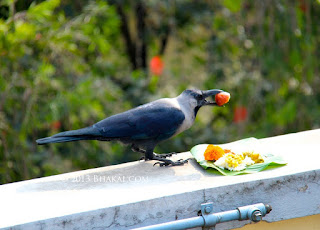Tihar
 We celebrate tihar for five days. It is the festival of lights as diyas and crackers. Tihar is the second biggest Nepalese festival after Dashain. The first day of Tihar is called 'Kag Tihar'. Crows are worshipped as the messengers of death.
We celebrate tihar for five days. It is the festival of lights as diyas and crackers. Tihar is the second biggest Nepalese festival after Dashain. The first day of Tihar is called 'Kag Tihar'. Crows are worshipped as the messengers of death.  The second day is called Kukur Tihar (worship of the dogs). It is also called the Khicha Puja by the Newars. Dogs, which are believed to be messengers of Lord Yamaraj, the God of Death, are worshiped each year on this day. People offer garlands, tika and delicious food to dogs and acknowledge the cherished relationship between humans and dogs.
The second day is called Kukur Tihar (worship of the dogs). It is also called the Khicha Puja by the Newars. Dogs, which are believed to be messengers of Lord Yamaraj, the God of Death, are worshiped each year on this day. People offer garlands, tika and delicious food to dogs and acknowledge the cherished relationship between humans and dogs.
The third day is the most important of all and is called Laxmi Puja. On this day, people worship cows. In Hinduism, a cow signifies prosperity and wealth. In ancient times, people benefited a lot from cows. Thus, on this day people show their gratefulness to cows by garlanding and feeding their cows with the best grass. Houses are cleaned and the doorways and windows are decorated with garlands made of Sayapatri (marigolds) and Makhamali flowers. In the evening, Goddess Laxmi, the goddess of wealth is thanked for all the benefits that were bestowed on the families by lighting oil lamps (Diyo) or candles on doorways and windows to welcome prosperity and well being. At night, the girls enjoy dancing and visiting all the houses of the neighborhood with musical instruments singing and dancing known as Bhaili all night long collecting money as tip from houses and share the bounty amongst themselves.
 On the fourth day of Tihar, there are three different known pujas, depending on the people’s specific cultural background. It is observed as Goru Tihar or Goru Puja (worship of the oxen). People who follow Vaishnavism perform Govardhan Puja, which is worship towards goverdhan mountain. Cowdung is taken as representative of the mountain and is worshiped. Additionally, majority of the Newar community on the night also perform “Mha/ Ma Puja” (worship of self). From this day onwards, Tihar is celebrated with Deusi. Deusi is mostly sung by the boys while the Bhailo is sung by the girls. Deusi is balladic in nature and tells the story of the festival, with one person in the group narrating and the rest as the chorus. In return, the house owners give them money, fruits and Selroti. Nowadays, social workers and politician along with young people visit local homes and sing these songs, and collect funds for welfare and social activities.
On the fourth day of Tihar, there are three different known pujas, depending on the people’s specific cultural background. It is observed as Goru Tihar or Goru Puja (worship of the oxen). People who follow Vaishnavism perform Govardhan Puja, which is worship towards goverdhan mountain. Cowdung is taken as representative of the mountain and is worshiped. Additionally, majority of the Newar community on the night also perform “Mha/ Ma Puja” (worship of self). From this day onwards, Tihar is celebrated with Deusi. Deusi is mostly sung by the boys while the Bhailo is sung by the girls. Deusi is balladic in nature and tells the story of the festival, with one person in the group narrating and the rest as the chorus. In return, the house owners give them money, fruits and Selroti. Nowadays, social workers and politician along with young people visit local homes and sing these songs, and collect funds for welfare and social activities.
The fifth and last day of Tihar is called Bhai Tika and is observed by sisters applying tika to the foreheads of their brothers to ensure long life and thanking them for the protection they provide.Sisters make a special garland for their brothers from a flower that wilts only after a couple of months.


Comments
Post a Comment